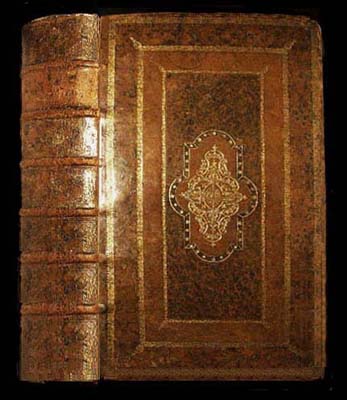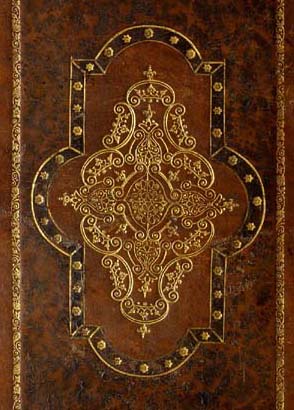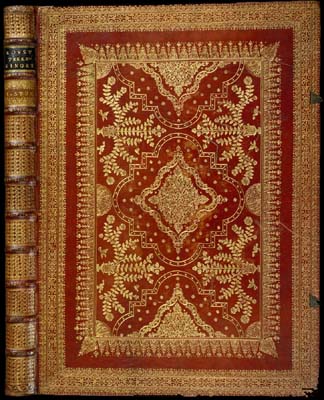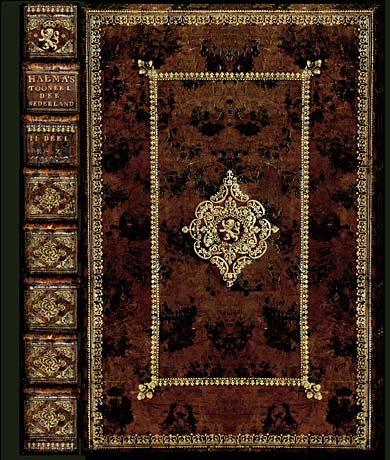

| Some months ago (spring of 2006) I found an extraordinary book or rather book and binding, what caught my eye was the marbled leather and elaborate center panel... |

| This is a huge folio book entitled "Alle de Wercken" by Jacob Cats, a 1726 Dutch publication. The binding alone too beautiful to pass up, I decided to add it to my already overcrowded shelves. I then started looking into Dutch eighteen century bindings and came across these important facts... |
|
The manufacturing of Dutch bindings flourished during the eighteenth century. Many
bindings from this epoch belong to the best and most beautiful crafted bindings ever
created in the Netherlands. The quality was of such high standards that it could easily
match with the high standards elsewhere in Europe and could easily compete with the
beautiful bindings from the capital of European bookbinding, Paris. Unlike France,
where bookbinding was strongly centralised in Paris alone, in the Netherlands luxury
bindings were produced in many towns. Not only the well known cities of Amsterdam,
The Hague and Middelburg, which were famous for their quality, originality and quantity
of luxury bindings, but many other trading centres like Rotterdam and university
towns of Leiden, Utrecht, Groningen, Harderwijk and Franeker were responsible for
many beautiful bindings.
Probably the best known expert in this field, is Dr. Jan Storm van Leeuwen, one cannot study Dutch bindings without coming across his name and so I decided to try to contact him. Dr. Storm studied Art History at the University of Utrecht and then from 1968 until his retirement in December 2005 he was employed by The Koninklijke Bibliotheek in The Hague, where he worked for the larger part of his career as a rare book librarian specializing in book bindings. He also lectured at the Plantin Society in Antwerp, Belgium and the Rare Book School in Charlottesville, USA. He has published many articles on books and the art and history of bookbinding, including De achttiende-eeuwse Haagse boekband in de Koninklijke Bibliotheek en het Rijksmuseum Meermanno-Westreenianum (The Hague, 1976) (which was his dissertation subject), The Hague bookbindings of the eighteenth century in the Royal Library and the Rijksmuseum Meermanno-Westreenianum. Probably there is no greater expert in the world as concerns Dutch bindings and so I was lucky and thankful to get his reply to my email. From the pictures I forwarded, Dr. Storm was able to identify the binding with certainty as being the work of the First Stadholder's Bindery. Dr Storm recommended that I get a copy of his book if wanted to learn more about this binding, which I did and from which is found the following information.... There were twenty or more different workshops producing de lux and semi-de lux bindings in the Hague in the eighteenth century. The most important in the first half of the century was without doubt the First Stadholder's Bindery ( Eerste Stadhouderlijke Binderij), from which one hundred and eighty semi-de lux and de lux bindings have been traced. This bindery bound a large number of presentation copies for William IV in fine bindings and made numerous semi-de lux bindings for manuscripts from the former Orange-Nassau collection for William V. Yet another eminent patron was the unknown person who had the covers of his bindings stamped in the center with a lion. The activities of this bindery can be divided into three periods. The most beautiful of its bindings belong to the first period from c. 1725 to 1749. At the onset they were decorated with strapwork in quatrefoil arrangements e.g. the bindings of the Fortification de la fee of 1728 and an album in which drawings could be mounted of c. 1736 (Cat. Nos.10, 33 Figs. 1,2). |

| Various bindings made at the end of the 1730's have cover decoration consisting mainly of leafy stems, such as those on the binding of Het blyde Breda (Cat. No. 35; Fig. 3). In the 1740's strapwork was used again, but now in patterns derived from the quatrefoil in lively compositions, as in the binding of Albinus' Tabulae in the Rijksmuseum in Amsterdam (see p. 68). |

|
The second period spans the years between 1749 and 1764 during which cover decoration became ever more sober, with the result that the bindings made after 1755 are, without exception, tooled in a simple pattern of one or more frames with center and corner pieces. From the third period are known only a few unattractive bindings, mainly for the prize volumes made between 1781 and 1793. From the periods just outlined can be gleaned a certain amount of biographical information which suggests that the bindings produced by the First Stadholder's Bindery may perhaps have been the work of the Stofvoet Family, Johannes (1687 - 1749) (who was admitted into the Hague guild in 1714. From 1733 until his death in 1749 he was commissioned to bind for the municipality) his wife Johanna Justina van Milaan who took over her husband's business on his death and continued to run it until her own death in 1764, and their son David (1720-95), who took over the bindery after his mother's death, but who presumably did little work as a binder since he was a clerk to the Town clerk. |
